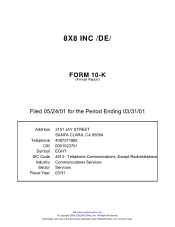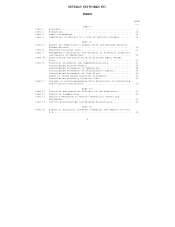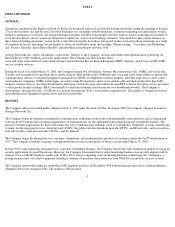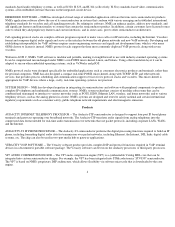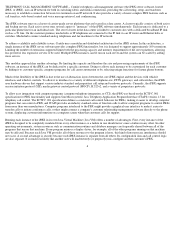8x8 2001 Annual Report Download - page 10
Download and view the complete annual report
Please find page 10 of the 2001 8x8 annual report below. You can navigate through the pages in the report by either clicking on the pages listed below, or by using the keyword search tool below to find specific information within the annual report.TELEPHONY CALL MANAGEMENT SOFTWARE -- Centile's telephony call management software (the iPBX server software, hosted
iPBX, or iPBX), uses an IP network for both its switching fabric and media connections, providing the call routing, setup, and teardown
necessary to establish a connection between two terminals on an IP network. It also provides a variety of more complex PBX features such as
call transfers, web-based control and voice message retrieval, and conferencing.
The iPBX software runs on a cluster of carrier-
grade server platforms that are located in a data center. A cluster typically consists of both active
and backup servers. Each active server runs several copies or "instances" of the iPBX software simultaneously. Each instance is dedicated to a
particular phone line for an individual user. The server cluster in the data center is linked to customer sites with a dedicated broadband IP link
such as a T1 line. On the customer premise, media hubs or IP telephones are connected to the IP link via an IP router and Ethernet hubs or
switches. Media hubs connect standard analog telephones and fax machines to the IP network.
To address scalability and reliability issues, Centile uses a modular and distributed architecture for the iPBX system. In this architecture, a
single instance of the iPBX server software provides complete PBX functionality, but it is designed to support approximately 100 extensions.
Limiting the number of extensions supported limits both the processing capacity and memory requirements of the server platform, allowing
less powerful, less expensive servers to be used. Multiple iPBX instances can be run on each server and the system can be scaled by adding
more servers.
This modular approach has another advantage. By limiting the capacity and therefore the size and processing requirements of the iPBX
software, an instance of the iPBX can be dedicated to a specific customer. Doing so allows each instance to be customized for each customer
by linking it to customer-specific computer programs for call center automation or by selecting unique functions for feature phone buttons.
Much of the flexibility of the iPBX is due to the use of abstraction layers between the core iPBX engine and the devices with which it
interfaces and which it controls. To allow it to interface to a variety of different telephone sets, PSTN gateways, and softswitches, the iPBX
uses hardware drivers that support various industry standard and proprietary call setup and teardown protocols. Currently, the iPBX supports
session initiation protocol (SIP), media gateway control protocol (MGCP), H.323v2, and a variety of proprietary protocols.
To allow easy integration with computer programs (computer telephony integration, or CTI), the iPBX was based on the ECTF C.001
specification for PBX functionality and supports Sun Microsystems' Java Telephony Application Program Interface (JTAPI) version 1.3 for
telephony call control. The ECTF C.001 specification defines a consistent call control behavior for PBXs, making it easier to develop computer
programs that can control a PBX, and JTAPI provides an industry standard series of function calls to allow computer programs to control PBXs
from more than one manufacturer. Computer programs interfaced to the PBX might provide a graphical user interface to make it easier to
transfer calls or initiate conference calls, or they might connect a company's customer relationship management software directly to the phone
system, displaying customer information on a computer screen when that customer calls for support.
Running each instance of the iPBX in its own Java Virtual Machine (Java VM) offers a number of advantages. First, every instance of the
iPBX is designed to be completely insulated from every other instance so a failure in one should never cause a failure in any other. In other
operating environments, system resources such as communication routines and database managers are frequently shared between all of the
programs that run on that machine. If one program misuses a display driver, for example, all of the other programs running on that machine
may be affected. Because each Java VM provides all of these resources to the program it hosts, this kind of inter-process interference should
not occur. A second advantage is security because each iPBX instance is separate from all others. Its configuration data and call control logic
are also separate. It is much less likely that another user will inadvertently (or purposely) mis-configure another customer's iPBX.
6

